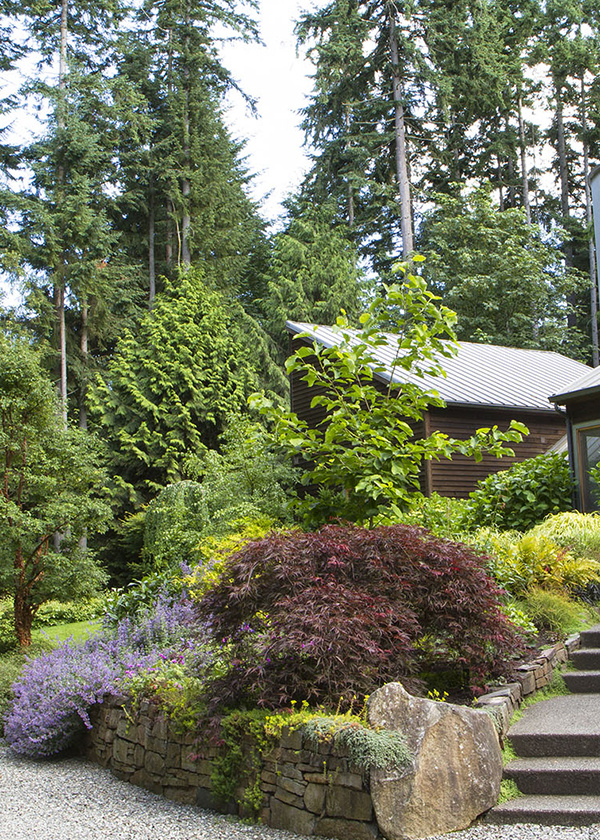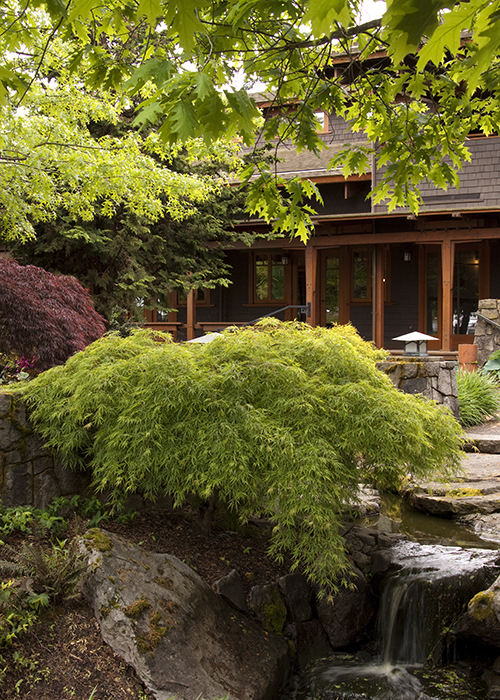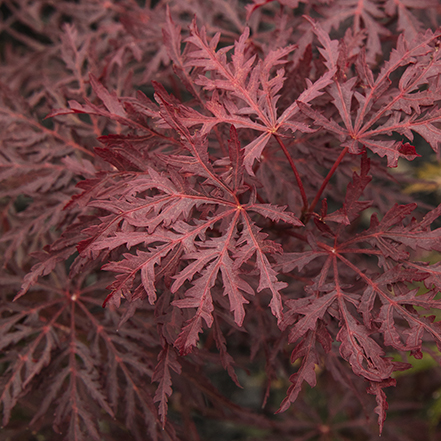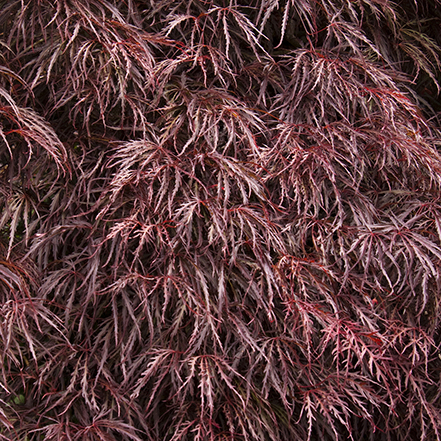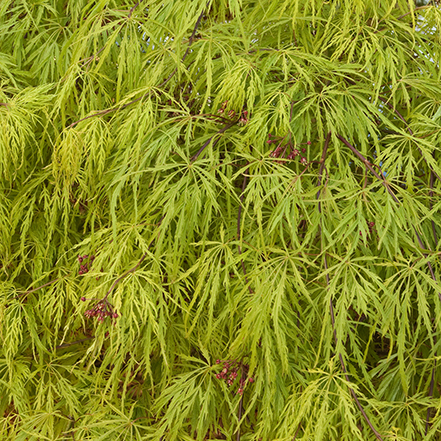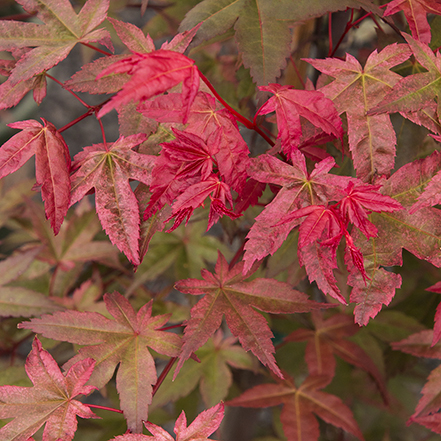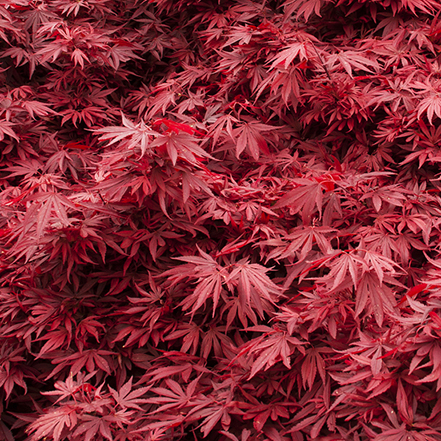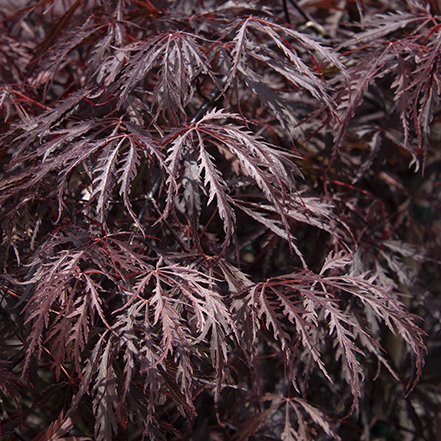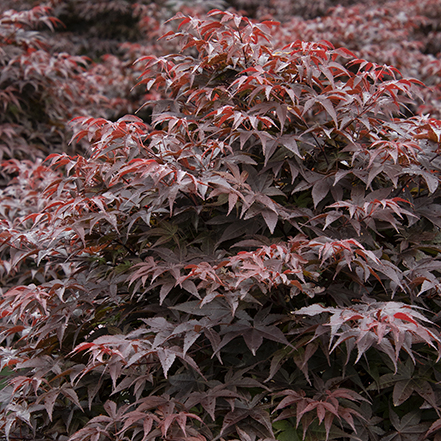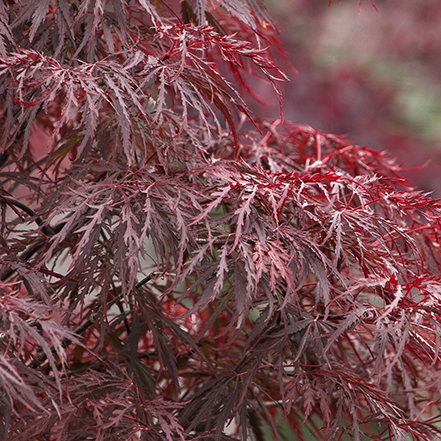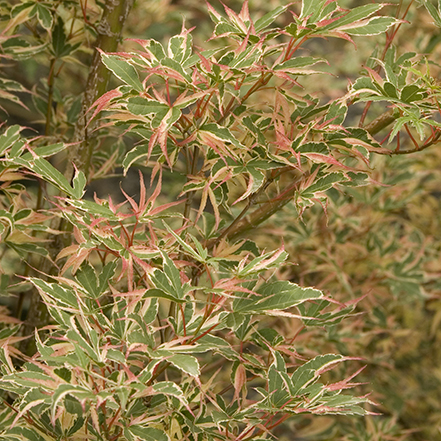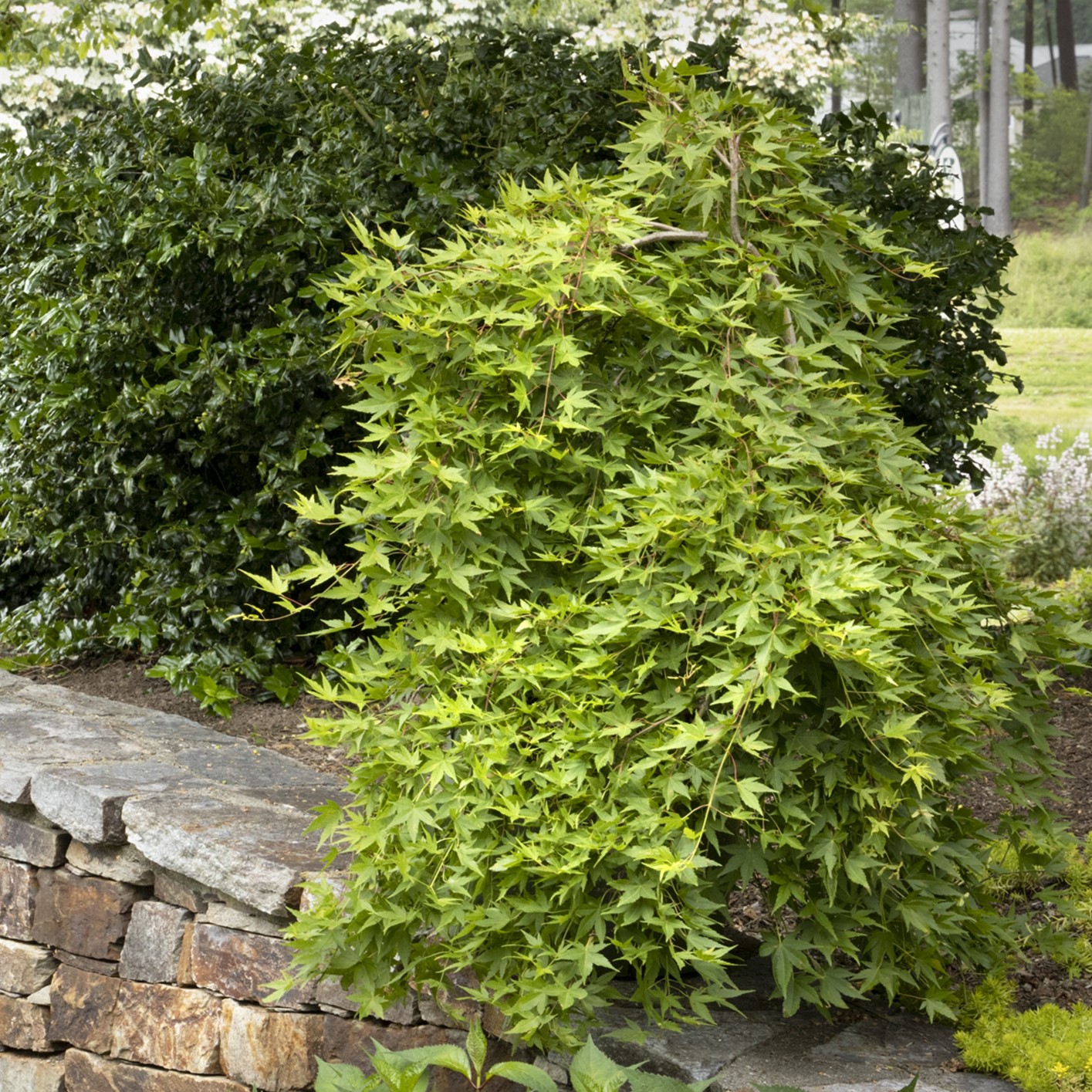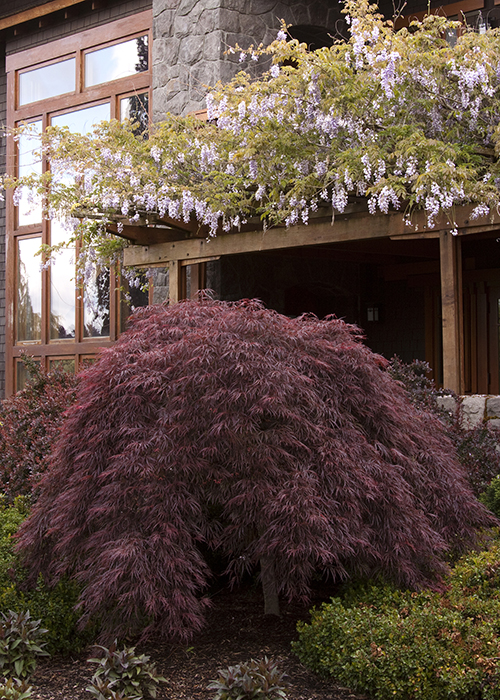Dwarf Japanese maples are treasured for their small size, elegance, and year-round interest. With unforgettable shapes and textures, these maples add a touch of beauty to even the tightest of spaces, and once they’re established, they are virtually carefree.
Both dwarf and larger varieties of Japanese maples are variations of the Acer palmatum species but they differ in size and growth characteristics. Dwarf Japanese maples are more compact, making them perfect for container planting, patios, and small gardens or borders. If you have a space where you think a dwarf Japanese maple would fit right in, check out our top ten options below, as well as a guide on how to care for them.
What is a Dwarf Japanese Maple?
Shown here: Waterfall Japanese Maple
A dwarf Japanese maple is a small, ornamental tree native to Japan and other parts of East Asia. Dwarf varieties are specifically bred or selected for their compact size and slower growth rate than regular Japanese maples. They offer a grand display with their foliage, perfect for many petite landscapes and gardens.
Specific Characteristics of Dwarf Japanese Maples
Dwarf Japanese maples have a grandeur that belies their small size. Some of the key characteristics of this plant include:
- Size: Dwarf Japanese Maples typically grow to a maximum height of 6-10 feet with a proportional spread, making them suitable for limited spaces.
- Growth Rate: These trees have a slower growth rate and tend to add 6-12 inches of growth per year, which contributes to their compact form and easier maintenance.
- Leaf Size and Shape: These maples exhibit the characteristic palmate leaves of Japanese maples but generally have smaller leaf sizes than their larger counterparts. Leaf shapes vary among different cultivars, ranging from deeply lobed to finely dissected.
- Foliage Colors: Like regular Japanese maples, dwarf Japanese maples offer a wide range of foliage colors that change throughout the seasons. Depending on the cultivar, they can display shades of green, red, purple, orange, and yellow, with striking autumn colors.
- Branching Structure: Dwarf Japanese maples often have a more compact and layered growth habit, with branches that may cascade or weep, adding a sense of elegance to the tree.
10 Dwarf Japanese Maples for Your Landscape
With these characteristics in mind, it’s time to find the perfect tree for your space. Don’t forget to consult our guide on how to select the right Japanese Maple for your environment. And in addition to our dwarf maple varieties, we’ve also got eclectic Japanese maples for you to explore.
Here are 10 of our best dwarf Japanese maples that will add striking beauty to your landscape.
The Velvet Viking™ Japanese Maple thrives in the full sun of cooler regions. This beautiful tree includes low, spreading branches on a beautifully mounded dwarf form. With rich red, dissected foliage, this plant holds its color throughout the growing season and develops more vibrant red tones in the fall. It’s a great container specimen that’s exceptionally cold-tolerant. Part to full sun. Up to 3' tall, 8' wide. Zones 4-9.
Crimson Queen Japanese Maple is a low-branching dwarf tree with a delicate form. Its foliage holds a beautiful crimson color during the summer and can turn bright scarlet in autumn. The Crimson Queen is sun-tolerant in cooler regions where sunlight intensifies its vibrant foliage color. Part to full sun. Up to 10' tall and wide. Zones 5-8.
The Waterfall Japanese Maple has a weeping habit that makes it the perfect specimen tree in garden beds and borders. The cascading branches and large, finely cut green leaves turn a golden color in fall. This tree does well in full or partial sun in cool climates or afternoon shade in hot areas. Up to 10' tall, 12' wide. Zones 5-8.
This Japanese maple is prized for its thrilling, highly dramatic foliage color. Its spring leaves are salmon-red, green in midsummer, then turn orange-scarlet in autumn. The Shin Deshojo’s new growth continues to emerge red and contrasts dramatically with the mature foliage. This maple does well in filtered sun, partial shade, and partial sun. Up to 9' tall and wide. Zones 5-8
The Shaina Japanese Maple is another fantastic option for an elegant container specimen. This dwarf maple has freely branching growth that becomes dense with maturity; its new foliage emerges bright red and matures to deep maroon. This striking maple makes for a great small lawn tree or a standout accent in your entryway garden. Part shade to full sun. Up to 8' tall, 10' wide. Up to Zones 5-8.
If you’re looking for a Japanese maple with a deeper color and gently weeping habit, the Tamukeyama Japanese Maple is a gorgeous choice. This graceful dwarf tree has waxy, deep-red bark and cascading branches. Its deeply lobed foliage is purple-red throughout the summer and turns bright red in the fall. Part shade to part sun. Up to 10' tall, 12' wide. Zones 5-8.
The Rhode Island Red Japanese Maple is packed with dense, compacting branching on an upright habit with a rounded crown. Its stunning foliage emerges red in the spring and deepens as it ages, and with cooler fall temperatures, orange tones emerge. In the winter, its red stems add color to its bare silhouette. This maple should not be exposed to harsh afternoon sun in hot summer areas, so keep that in mind when choosing a site for this beautifgul tree. Part shade to full sun. Up to 6' tall and wide. Zones 5-9.
The Red Dragon Japanese Maple has deeply dissected, deep-purple leaves that have a fine, lacy appearance. This unique texture adds visual dimension to other broader-leaved trees and shrubs. It's another great container specimen and deserves to be enjoyed as a focal point. When temperatures cool in the fall, the foliage becomes a bright red. Part to full sun. Up to 8' tall, 5' wide. Zones 5-8.
Looking for a less traditional Japanese maple? The Kagiri Nishiki maple fits the bill. It has pink and white irregular margins on its light-green leaves, with pink tones more pronounced in the fall. It’s a fine, slow-growing, vase-shaped tree perfect in Asian-themed gardens or courtyards. Part shade to full sun. Up to 8' tall, 4' wide. Zones 5-8.
This exceptional variety from Japan is unlike any other. With green palmate leaves that are generally characteristic of upright varieties, Ryusen is a weeping form with rapid growth that shoots straight up and cascades down. Though tall, its exceptionally slim profile makes it excellent for narrow spaces. Bright yellow and orange-red fall color adds to its beauty. Up to 20' tall, 5 to 6 ft. wide. Zones 5-7.
How to Grow and Care for Dwarf Japanese Maples
Dwarf Japanese maples are really easy to care for if grown in the right conditions. There are a few steps you’ll need to take to make sure your tree has the optimal conditions to thrive. Remember that these are general guidelines, and you’ll need to consult specific care instructions for the particular cultivar of maple you choose.
Shown here: Crimson Queen Japanese Maple
- Choose the Right Location: Most dwarf Japanese maples do well in well-drained soil and prefer a location with partial shade. Select a spot that receives morning sun and afternoon shade or filtered sunlight throughout the day. Ensure the area has enough space for the tree to reach its mature size without being crowded by other plants or structures.
- Prepare the Soil: Ensure the soil is well-draining, rich in organic matter, and not too heavy or clay-like. This will provide a favorable environment for the tree’s root development.
- Dig the Hole: Dig a hole that is twice as wide and slightly shallower than the root ball of the tree. The hole should be wide enough to accommodate the spread of the roots. Loosen the soil at the bottom of the hole to allow for root penetration.
- Position the Tree: Gently remove the tree from its container, being careful not to damage the roots. Place the tree in the planting hole, ensuring the root collar (where the trunk meets the roots) is level with or slightly above the soil surface.
- Backfill the Hole: Fill the hole with the soil you removed, gently tamping it down around the roots to eliminate air pockets. Avoid compacting the soil too firmly, as this can hinder root growth. Water the tree periodically while backfilling to settle the soil.
- Mulch and Water: Apply a layer of mulch (such as wood chips or shredded bark) around the tree’s base, but avoid piling it against the trunk of the tree. Mulch helps conserve moisture, regulate soil temperature, and suppress weeds. Water the newly planted tree to ensure the soil is evenly moist. It's very important to provide regular watering during the establishment period, keeping the soil consistently moist but not waterlogged.
- Maintain and Care for the Tree: Regularly water your dwarf Japanese maple, especially during dry periods, to keep the soil moist. Avoid overwatering or allowing your tree to sit in soggy soil. You can prune your tree as needed to remove any dead or damaged branches and preserve its charming shape.
Frequently Asked Questions
How big does a dwarf Japanese maple get?
Most dwarf Japanese maples grow up to 10 feet, though size varies depending on the type of tree.
Can a dwarf Japanese maple take full sun?
It depends on where you live and how hot it gets in the summer. While some dwarf Japanese maples can take full sun, most of these trees prefer dappled or afternoon shade. If you live in a hot, dry area, you should be especially careful not to site your tree in a full sun location.
Do dwarf Japanese maples lose leaves in winter?
Yes. These trees are deciduous and shed their leaves during the winter season.
Can you water a Japanese maple too much?
Yes. Although most Japanese maples prefer moist soil, it should never be soggy. If your tree is overwatered, its leaves may become yellow or blackened.
Get more information about Gardening with Japanese Maples
Check out the Care sections of each Japanese maple plant page. Then, explore some of our most popular articles about growing Japanese maples:
- Get the 2022 and 2023 "Simply Beautiful" design guides to learn how Japanese maples fit into a straightforward approach to garden design
- Make an Impact with These Unusual Types of Japanese Maples
- Best Small Trees for Fall Color: Favorites for red, orange, and yellow fall foliage
- How to Select the Right Japanese Maple
- 10 Facts Every Japanese Maple Lover Needs to Know
- Video: How to Plant a Japanese Maple
Sign up for the Grow Beautifully newsletter to get first access to digital guides, live webinars, design advice, and so much more.





